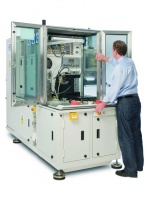SPE machine helps OEMs test fuel pumps
A novel machine measures the key parameters of automotive diesel fuel pumps and injection systems.


’While such mechanical systems did overcome the difficulties caused by the inertia of the cams inside the pump, the inertial mass of the flywheel itself meant that they were unable to achieve the acceleration or deceleration times that were now being demanded by the automotive OEM,’ said Baker.
Being unable to decelerate quickly also meant that, should any pump failure such as a seizure occur, the older flywheel-based machines were unable to stop before the pump itself was destroyed. Hence, the OEM had no way to investigate any potential causes of failure after such an event. With the S400 machine, however, there are no such difficulties.
’By comparing the digital output from an encoder on the back of the motor with the output of an encoder on the front of the pump, the new machine is able to quickly detect when a pump might be starting to fail. If it is, then a slip coupling on the front of the machine can disengage the pump from its load and the machine can be brought to a halt so that the pump can be removed and examined in detail,’ said Baker.
As the system exorcises the pump through different cycles, a sophisticated acquisition system collects data from sensors around the machine.
Register now to continue reading
Thanks for visiting The Engineer. You’ve now reached your monthly limit of premium content. Register for free to unlock unlimited access to all of our premium content, as well as the latest technology news, industry opinion and special reports.
Benefits of registering
-
In-depth insights and coverage of key emerging trends
-
Unrestricted access to special reports throughout the year
-
Daily technology news delivered straight to your inbox










Water Sector Talent Exodus Could Cripple The Sector
Maybe if things are essential for the running of a country and we want to pay a fair price we should be running these utilities on a not for profit...